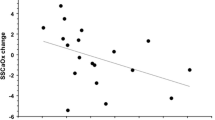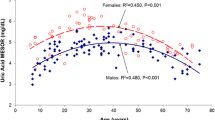Abstract
The chronome of lipid peroxidation and anti-oxidant defense mechanisms may relate to the efficacy and management of time qualified preventive therapeutic and dietary interventions. One hundred renal stone patients, 20–60 years of age, and 50 clinically healthy volunteers, 21–45 years, were synchronized for 1 week with diurnal activity from 06:00 to 22:00 and nocturnal rest. All subjects took their usual meals three times daily (breakfast around 08:30, lunch around 13:00, and dinner around 20:30) with usual fluid intake. Drugs known to affect free radical system were not taken. Blood samples were collected at 6-h intervals for 24-h under standardized, presumably 24-h synchronized conditions. Determinations included plasma lipid peroxides, in terms of malondialdehyde (MDA) and blood superoxide dismutase (SOD), glutathione peroxidase (GPx), glutathione reductase (GR) and catalase (CAT) activities. A marked circadian variation was demonstrated for each studied variable by population-mean cosinor in renal stone patients and healthy participants (p < 0.001). By comparison to healthy subjects, parameter tests indicate that the stone formers had a higher MESOR of MDA, but a lower MESOR of SOD, GPx, GR and CAT. Furthermore, the patients also differed from the healthy controls in terms of their circadian amplitude and acrophase (tested jointly) of all variables (p < 0.001). Mapping the broader time structure with multifrequency circadian characteristics of oxidants and anti-oxidants is needed for exploring their role as marker in the treatment and management of urolithiasis.
Similar content being viewed by others
References
Strohmaier WL. Recent advances in understanding and managing urolithiasis [version1; referees:3 approved]. F1000Research. 2016;5(F1000 Rev):2651.
Kizivat T, Smolic M, Maric I, Levak ML, Smolic R, Curcic IB, et al. Antioxidant pre-treatment reduces the toxic effects of oxalate on renal epithelial cells in a cell culture model of urolithiasis. Int J Enviorn Res Public Health. 2017;14:109–33.
Hesse A, Brändle E, Wilbert D, Köhrmann KU, Alken P. Study on the prevalence and incidence of urolithiasis in Germany comparing the years 1979 versus 2000. Eur Urol. 2003;44(6):709–13.
Strohmaier WL. Economics of stone disease/treatment. Arab J Urol. 2012;10(3):273–8.
Moore-Ede MC. Physiology of the circadian timing system: predictive versus reactive homeostasis. Am J Physiol. 1986;250:R737–52.
Moore-Ede MC, Herd JA. Renal electrolyte circadian rhythms: independence from feeding and activity patterns. Am J Physiol. 1977;232:F128–35.
Eknoyan G. History of urolithiasis. Clin Rev Bone Miner Metabol. 2004;2:177–85.
Ramello A, Vitale C, Marangella M. Epidemiology of nephrolithiasis. J Nephrol. 2000;13(Suppl):S45–50.
Stamatelou KK, Francis ME, Jones CA, Nyberg LM, Curhan GC. Time trends in reported prevalence of kidney stones in the United States: 1976–1994. Kidney Int. 2003;63:1817–23.
Singh RK, Bansal A, Bansal SK, Singh AK, Mahdi AA. Circadian periodicity of urinary inhibitor of calcium oxalate crystallization in healthy Indians and renal stone formers. Eur Urol. 1993;24(3):387–92.
Singh RB, Niaz MA, Cornelissen G, Otsuka K, Siegelova J, Fiser B, et al. Circadian rhythmicity of circulating vitamin concentrations. Scripta Medica (Brno). 2001;74(2):93–6.
Mills JN. Human circadian rhythms. Physiol Rev. 1966;46:128–71.
Berg W, Brundigg P, Bothor C, Schneider J. Biological rhythmicity and crystallization—urine profiles and Se-studies on calcium oxalate stone genesis. Int Urol Nephrol. 1982;14:363–72.
Singh R, Singh RK, Tripathi AK, Gupta N, Kumar A, Singh AK, et al. Circadian periodicity of plasma lipid peroxides and antioxidant enzymes in pulmonary tuberculosis. Ind J Clin Biochem. 2004;19(1):14–20.
Singh R, Singh RK, Mahdi AA, Singh RK, Kumar A, Tripathi AK, et al. Circadian periodicity of plasma lipid peroxides and other antioxidants as putative markers in gynecological malignancies. In Vivo. 2003;17:593–600.
Singh R, Singh RK, Tripathi AK, Cornelissen G, Schartzkopff O, Otsuka K, et al. Chronomics of circulating plasma lipid peroxides, antioxidant enzymes and other related molecules in cirrhosis of liver. In the memory of late Shri Chetan Singh. Biomed Pharmacother. 2005;59(Suppl 1):S229–35.
Singh R, Singh RK, Masood T, Tripathi AK, Mahdi AA, Singh RK, et al. Circadian time structure of circulating plasma oxides, antioxidant enzymes and other small molecules in peptic ulcers. Clin Chim Acta. 2015;451:222–6.
Kushwaha RS, Gupta RC, Sharma JP, Sharma S, Singh RK, Cornelissen G. Circadian periodicity of plasma lipoid peroxides, uric acid and ascorbic acid in renal stone formers. Ind J Clin Biochem. 2017;32(2):220–4.
Ohkawa H, Ohishi N, Yagi K. Assay for lipid peroxides in animal tissues by thiobarbituric acid reaction. Anal Biochem. 1979;95(2):351–8.
McCord JM, Fridovich I. Superoxide dismutase. An enzymic function for erythrocuprein (hemocuprein). J Biol Chem. 1969;244(22):6049–55.
Pagila DE, Valentine WN. Studies on the quantitative and qualitative characterization of erythrocyte glutathione peroxidase. J Lab Clin Med. 1967;2:158–69.
Hazelton GA, Lang CA. GSH content of tissue in aging mouse. Biochem J. 1980;188:25–30.
Aebi H, Suter H. Protective function of reduced glutathione against the effect of pro-oxidative substances and of irradiation in the red Cell. In: Flohe I, Benhar HC, Sies H, Waller HD, Wendel A, editors. Glutathione. Stuttgart: Georg Thieme; 1974. p. 192–9.
Halberg F, Johnson EA, Nelson W, Runge W, Sothern R. Autorhythmometry-procedures for physiologic self-measurements and their analysis. Physiol Teach. 1972;1:1–11.
Bingham C, Arbogast B, Cornelissen G, Lee JK, Halberg F. Inferential statistical methods for estimating and comparing cosinor parameters. Chronobiologia. 1982;9:397–439.
Cornelissen G, Halberg F. Chronomedicine. In: Armitage P, Colton T, editors. Encyclopedia of biostatistics, vol. 1. Chichester: Wiley; 1998. p. 642–9.
Elliot JS, Euseblio E. Calcium oxalate solubility. The effects of trace metals. J Invest Urol. 1967;9:428.
Tungsanga K, Sriboonlue P, Futrakul P, Yachantha C. Renal tubular cell damage and oxidative stress in renal stone patients and the effect of potassium citrate treatment. Urol Res. 2005;33(1):65–9.
Cornélissen G, Halberg E, Halberg F, Halberg J, Sampson M, Hillman D, Nelson W, Sánchez de la Peña S, Wu J, Delmore P, Marques N, Marques MD, Fernandez JR, Hermida RC, Guillaume F, Carandente F. Chronobiology: a frontier in biology and medicine. Chronobiologia. 1989;16:383–408.
Singh RB, Hristova K, Pella D, Feckado J, Chaves H, Mondal RN, et al. Extended consensus on guidelines for assessment of risk and management of hypertension. A scientific statement of the International College of Cardiology—Thank you Dr Franz Halberg. World Heart J. 2014;6(1):63–72.
Bonny O, Firsov D. Circadian clock and the concept of homeostasis. Cell Cycle. 2009;8:4015–6.
Firsov D, Bonny O. Circadian regulation of renal function. Kidney Int. 2010;78:640–5.
Zelko I, Mariani T, Folz R. Superoxide dismutase multigene family: a comparison of the CuZn-SOD (SOD1), Mn-SOD (SOD2), and EC-SOD (SOD3) gene structures, evolution and expression. Free Radic Biol Med. 2002;33:337–49.
Banniste J, Bannister W, Rotilio G. Aspects of the structure, function, and applications of superoxide dismutase. CRC Crit Rev Biochem. 1987;22:111–80.
Ma MC, Chen YS, Huang HS. Erythrocyte oxidative stress in patients with calcium oxalate stones correlates with stone size and renal tubular damage. Urology. 2014;83(2):510.
Khan SR. Hyperoxaluria-induced oxidative stress and antioxidants for renal protection. Urol Res. 2005;33(5):349–57.
Wilson JF. Facing an uncertain climate. Ann Intern Med. 2007;146:153–6.
Fakheri RJ, Goldfarb DS. Ambient temperature as a contributor to kidney stone formation: implications of global warming. Kidney Int. 2011;79:1178–85.
Taylor EN, Stampfer MJ, Curhan GC. Obesity, weight gain, and the risk of kidney stones. JAMA. 2005;293:455–62.
Acknowledgements
The authors are grateful to Hon. Chairman, Shri Guru Ram Rai Education Mission for his constant support and guidance in pursuing such studies in our laboratory. We are also indebted to the staff of the Department of Biochemistry, SGRR Institute of Medical and Health Sciences for their technical assistance. Our special thanks to Dr Rachit Garg for patient enrolment.
Author information
Authors and Affiliations
Corresponding author
Ethics declarations
Conflict of interest
The authors declare that they have no conflict of interest.
Rights and permissions
About this article
Cite this article
Kushwaha, R.S., Gupta, R.C., Sharma, S. et al. Chronomics of Circulating Plasma Lipid Peroxides and Antioxidant Enzymes in Renal Stone Formers. Ind J Clin Biochem 34, 195–200 (2019). https://doi.org/10.1007/s12291-017-0726-6
Received:
Accepted:
Published:
Issue Date:
DOI: https://doi.org/10.1007/s12291-017-0726-6




